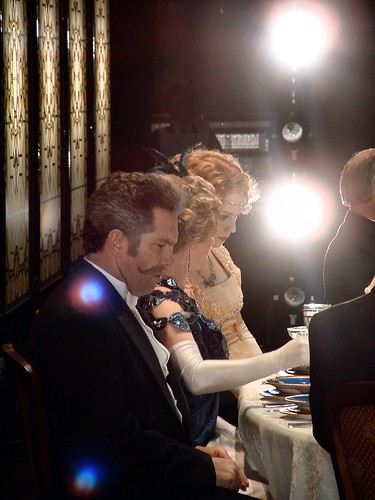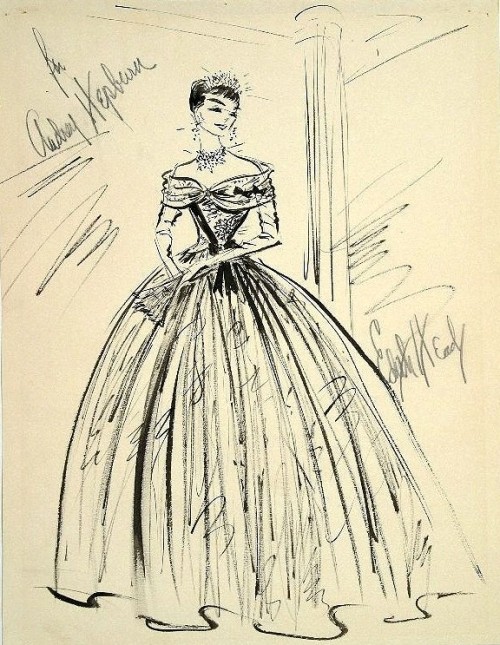Ever since I did
a costume analysis of Julian Fellowes' Titanic miniseries, I've had a spot of
Titanic fever. I don't know what it is, but something about the tragedy is at once haunting and fascinating. Maybe it's the thousands of emotional stories that came from that one night. Maybe it's the comparison in classes; the decadence with which some lived and the poverty of others. Maybe it's the clothes. You know I'm a sucker for the clothes.
Whatever the reason, I was very excited when I discovered that there's actually a
musical that tells the story of passengers aboard the doomed ship. I poked around on YouTube, hoping to find some clips of the show, and happened across
this full video of the 2006 Australian production. I watched five minutes of it here and there and managed to get through the whole thing. Several hours and buckets of tears later, I'm ready to tell you all about it.
This review is
spoiler-free.
The first thing you need to know about this show is that it isn't an adaptation of James Cameron's
Titanic film. In fact, as I found out as I researched it, the show premiered in 1997, a few months before the film did (and picked up five Tonys, I might add). In plot, it more closely resembles the Julian Fellowes series, in that it follows the stories of several different characters through strung-together vignettes. Characters from all social classes are represented, from the American millionares and British aristocracy in first class to the Irish immigrants and coal-covered stokers in steerage. All of the characters in the show are based off of real people to some extent, with ship designer
Thomas Andrews, owner
J. Bruce Ismay, and captain
Edward Smith all playing pivotal roles in the plot. Some characters, like spunky Irish lass Kate McGowan, are compilations of multiple passengers' stories.
One of the very first things that made an impression on me as I watched was the set. It's beautiful in its simplicity; for the majority of the show, we have nothing but a starry backdrop and a suspended walkway to show the chilly nights on deck. A few other set pieces fly in and out to show the docks, the first class dining room, and other scenes on the ship. Another interesting feature is the time and date that's occasionally projected onto the set to keep the audience updated on the timeline of the show. An eerie, but captivating effect takes place after the ship hits the iceberg at the end of the first act (spoiler!). The entire set is put on a tilt, which gets steeper as the story progresses and the
Titanic sinks deeper into the water.
I feel like I should pause a moment and tell you a bit about the costumes. It's only fair, considering the fact that this is mainly a costume blog. The costumes were historically accurate and fit the characters who wore them, but they were also very unobtrusive to the story, which I appreciated. From what I've seen, a lot of other productions go a little crazy with the costumes (the costumes for the American characters get especially wacky. Thanks, guys), which really feels unfitting for such a somber story. However, this production did have a little fun with their millinery, but honestly, would it be a 1910's costume drama without it? The lower class ladies wore shirtwaists, plain skirts, and jackets. Upper class ladies had glittering gowns and tailored traveling suits.
The score is yet another high point of this show. It's beautifully written, and wonderfully performed by the cast I watched. There isn't a bad voice in the cast (and that's coming from me as a picky theatre-goer/YouTube-watcher), and the musicians in the pit handle the soaring orchestration perfectly. With such talented singers and musicians, every single number in the musical is a showstopper. That might be one of my only complaints about the show. Since every number is so emotional, the story does tend to get heavy at times, with no moments of levity (with the exception of some funny lines of dialogue and the song "The Latest Rag" which incorporates period-accurate ragtime music and a lively dance sequence) to break up the drama. "Still" is a particularly moving duet about the lasting love between real-life couple Isidor and Ida Straus, who were married for more than forty years and refused to be separated during the disaster.
As I mentioned before, this cast is absolutely superb, and not just musically. There are some beautifully acted scenes, particularly in the captain's bridge, where a few men are completely aware of the fact that they are responsible for thousands of lives. I didn't realize until after I finished watching the video that this production was Australian. Although some of their Irish and American accents could use a little work (particularly second class American Alice Beane, whose over-energetic fawning over the first class passengers becomes a little grating on the ears), their British accents are superb. An honorable mention goes to the actor playing crew member Mr. Murdoch, who has a flawless Scottish brogue (or at least it sounds flawless to these American ears).
When I did my costume analysis for the Julian Fellowes series, I talked about how the most riveting part of the story was finding out who lives and who dies. The same holds true for this show. Some of the 30+ characters are more lovable than others, but all of them are interesting, and the show does a good job of balancing the multiple plotlines to give each one the development it needs. The only thing that bothered me about the script was the oft-repeated line "it's a new world out there." At least five different characters who have no relation to one another say this in several independent cases. We get it. The
Titanic was a huge step forward in technological progress.
One of my favorite characters was the relatively small role of Harold Bride, the radioman on the
Titanic. His song "The Night Was Alive," wasn't my favorite in the show (mainly because it was layered with "The Proposal," and Harold singing about his love for his job while another man was singing about his love for his sweetheart was downright awkward), but the beautiful lyrics and occasional verse sung in Morse code were really interesting.
There are so many more lovely moments in this show that I'd love to tell you about, but I really shouldn't. You just have to experience it for yourself.
Titanic: The Musical is so emotional, and the story is so gripping. The events of that fateful night are told in a respectful, historically accurate, and creative way. It's a dream come true for history nerds.
Watch it on YouTube here.
And now for some legal stuff.
I don't own Titanic: the Musical. If I did, I would bribe the producers to cast me in the show, after which I would run around in a giant, feather-and-flower-covered hat. I'm also not making any profit from this blog post. If you have any reason to believe that the YouTube video I've promoted on this blog posted by the user MusicalFrance is pirated or illegal in any way, let me know, and I'll remove the content.
See you tomorrow for Fashion in Film!





















































